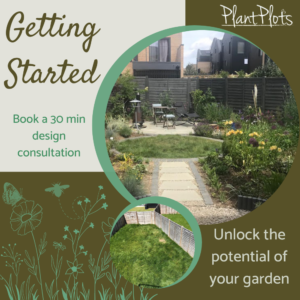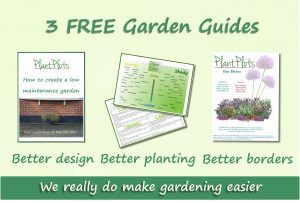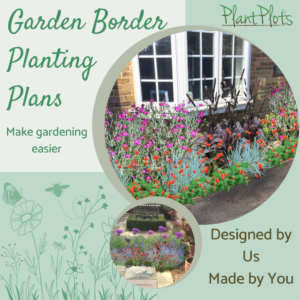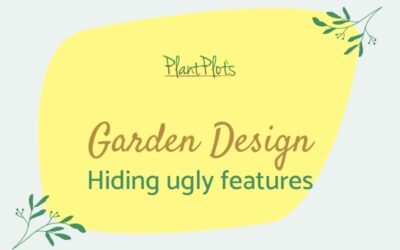
Oh my goodness, what do you do with a really steep slope of untamed grass and a desire to have something nice to look at! This week is all about how you go about planting a garden on a slope. For more help and advice watch our design videos
What problems arise when planting on a slope?
Before starting the potential problems need looking at and thinking through before you don crampons, attach ropes and climb the garden armed with a spade!
What could go wrong, what will go wrong and how do you stop that from happening? Planting on any sloping garden has its own unique set of problems, so what are these?
- Access and maintenance
- Drainage and runoff
- Erosion
- Differing light levels
- The effect of Perspective
Access and Maintenance:
How much is the garden going to be used?

The design the garden takes needs to really reflect how much use it will have as opposed to how much use you think it will have. For example, at the top of the garden, there is a lovely view, but access to it is awkward. The standard design model would create a seating area at the top of the garden to maximise the view.
The question though, is whether installing a patio will mean everyone makes the effort to climb to the top to use it.
Are you really going to traipse to the top with a cup of tea each time you want to sit outside for just a few minutes?
Maintaining a garden on a slope is tricky, let’s face it, the weeding can be a real chore at the best of times, but add to that the added ‘faff’ factor of climbing up a slope as well, and one’s enthusiasm for a gorgeous manicured haven of flowers could be hard to achieve!
There are some basic rules of thumb though that designs can follow:
- Create one flat space to sit out in, that holds a table and chairs AND is simple to access from the house.
- Terracing the garden will allow more of it to be usable BUT it is expensive to install. Ensure the flat bits are created where the nicest parts of the garden to sit in are. Terraces don’t need to be evenly spaced or identical heights
- Accept that maintenance is more difficult on a slope, so choose plants that won’t grow too quickly!
Drainage and Runoff:

Now, this is blindingly obvious, but sadly often not considered properly. Rainfall will run down the slope, no surprises there; but what this means is those plants at the top of the slope need to be able to suck up the moisture quickly before the water drains away AND what happens at the bottom of the slope!
The slope will channel the water downhill, so what is at the bottom, your patio, a retaining wall… the back door?
Over-compensate for water runoff. The climate crisis means more intense rainfall, so, factor that in when designing the drainage channels at the bottom of the slope.
Plants at the top of the slope need to be more drought tolerant, those at the bottom need to be better at sucking up rainfall
Erosion:
Gravity is a problem on a slope; all the forces point to the bottom of the slope. Everything will fall downhill unless there is a force holding it in place. Take the example of this sloping garden, currently, it is grassed over, and the knitted root system is the force holding everything in place. The roots bind the soil in place, remove the grass and the soil will look to slide to the bottom.

So what does this mean, well, you need to create new forces to hold the soil on the slope. Creating a terrace adds the retaining force back in. If the slope is not going to be terraced, then the plants will have to hold the soil in place.
The best plants to choose then are those plants that spread via underground roots.
These root systems will gradually weave together and help prevent soil erosion. Plants such as Persicaria, Lysimachia, Mint or Pachysandra which in a normal garden might be too vigorous, on a sloping space will quickly fill bare patches and help knit the soil together.
Ensure 80% of the plants have good root systems to help keep the soil on the slope.
Light levels:
It may not seem to be that important, but there is less light at the bottom of a slope, purely because is falls into shade sooner than at the top of the slope – this is more pronounced on north facing slopes. If taller plants are placed at the top of the slope, their shadows drop light levels even further. It is not a massive problem, just one you need to consider before you plant.
Most garden designers and landscapers would always recommend terracing sloping gardens. Terracing levels parts of the garden and improves access, so this must be a good thing. Well perhaps yes and perhaps no, and this is why.
Sloping gardens are undoubtedly a design challenge, but the slope itself should not be regarded as the problem that must be designed out. The slope can provide opportunities for a more interesting garden. This post about designing a garden on a slope aims to show how to work with the terrain of the garden to create a more usable space, without spending a fortune on terracing!
Basic Design Principles when dealing with a slope
There are 4 basic principles to remember:
- Up slopes make the garden appear shorter.
- Down slopes give the appearance of a long garden.
- Bright colours tend to appear closer than paler pastel colours.
- Surface water runoff and drainage are issues that need to be addressed
One train of thought is that the slope is a waste of garden space, as such using terracing to create more level areas in the garden must make the garden a more usable space – and indeed it does. However, the question that perhaps needs asking is this; how much extra benefit will have 2-3 flat areas of the garden make, compared to the cost of creating the terraces?
Do sloping gardens waste valuable space?
The usability and function of any garden is obviously very important, especially as gardens are shrinking in size. Modern gardens need to work harder to ensure you get maximum benefit. So, having a space that is not flat must then render it unusable and as such wasted, surely? Well only if that part of the garden IS the part of the garden you would prefer to sit. If the slope is in an area that you would not want to use, how does the terrain adversely affect your life?
Using terracing to create extra flat areas will not make you use that part of the garden. You will have just spent a lot of time and effort levelling off ground. It is really important then to consider what you would actually use the space for before you start digging.

Just because you pop a chair on the top terrace, it won’t make you sit there if it’s easier (and sunnier) nearer the house.
There are 3 questions to ask of any garden, flat or sloping, that determine the starting point for any design:
- Where is the nicest part of the garden to sit?
- How do you get there?
- Once there, what is worth looking at?
The issue of the slope, at this stage, does not come into it. So in the above image, the top terrace has a little seating area, which is lovely IF that is the part of the garden that gets the sun at the time the owners are most likely to want to sit out. We are inherently lazy creatures (in spite of our best intentions), you simply will not bother to walk uphill to a top terrace unless that terrace IS worth sitting on.
Sloping gardens do not then waste space but terracing can waste a lot of money!
Simply creating a terraced seating area will not make you use it. In addition, building and landscaping a terrace is very expensive. But if ALL of the garden is not used once it’s built, the cost-benefit ratio is out of balance. Which means money, time and resources have been wasted.

An alternative approach
This alternative viewpoint focuses more on how you would use the garden, this creates areas of used and unused space. The used areas need to be flat and accessible, the rest of the slope can be left as it is; you would not be walking or sitting in these areas. These areas can use plants to disguise the contours of the land, giving the impression of terracing without the expense of actually building it.

Imagine using plants to give the impression of terracing instead, Lavender for example; loves good drainage, and thrives in the sunshine and poor soil. Plant the lavender across the plane of the slope, leaving gaps between the rows. infill the gaps with plants that vary in height, the rows of lavender become the levelling elements, disguising the slope. Plants like box or sarcococca can be used in the same way if the slope is less sunny.
The horizontal lines the plants give the impression of terracing, large boulders can also be used.
To make a more interesting garden display, vary the heights of the plants used, if all the plants added are the same height or shape, the angle of the slope is just highlighted. Use tall upright plants to hide the contours of the slope.
Finally, what would make you go to the end of the garden?
If this involved walking up or down a slope, there must be a reason to venture to the end. Just having somewhere to sit is not enough. It needs to be somewhere that is worth the effort it takes to get there. Instead of just a seat, have swing seat, or a focal point that invites a closer look; or even better, make the journey either there or back just full of fun.

It wouldn’t just be the kids that went down the slide, would it?
It is not that terracing a garden is a bad option, it’s just an expensive one. If reading this post it just makes you think about how you will use the garden. Rather than creating areas you might use, the garden created will be better.
Planting ideas
Border Plans and Garden Advice
Unsure what plants to use? No problem, just use one of the border designs we have created. You’ll know what to plant, how many to use and how to look after them.














